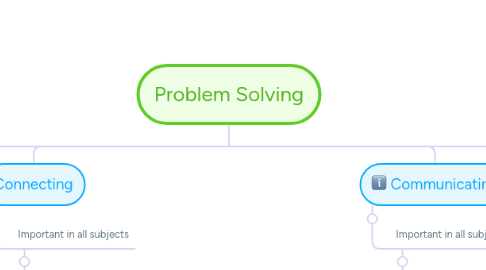
1. Connecting
1.1. Important in all subjects
1.1.1. The perpetuation and motivation for all learning is the ability to connect learning to our own lives, knowledge, interests, and experiences. If there is no connection or interest, there is no learning.
2. Communicating
2.1. Important in all subjects
2.1.1. Verbal-linguistic, visual spatial, musical-rhythmic and/or interpersonal intelligence
2.1.1.1. Allow students to represent their learning through oral or written works, the arts by creating something or through music; allow students to work in cooperative groups
2.1.1.1.1. Have a variety of choices and tools available, as well as space, for students to meet in groups, move and create to show their learning
3. Representing
3.1. Important in all subjects, but particularly in art, math, and science
3.1.1. Visual-Spatial and/or Kinesthetic Intelligence
3.1.1.1. Allow students to represent their learning through the arts by creating an artwork or through other active means
3.1.1.1.1. Have a variety of choices and tools available, as well as space, for students to move and create to show their learning
4. Reflecting
4.1. Important in all subjects
4.1.1. Intrapersonal intelligence
4.1.1.1. Allow for students to work independently
5. Reasoning & Proving
5.1. Important skills for all subjects, but particularly important in language, science and mathematics
5.1.1. Mathematical-logical intelligence
5.1.1.1. Have students regularly explain their thinking and provide evidence to support their thinking
5.1.1.1.1. Provide scaffolding through the use of prompts and open ended questions
6. Selecting Tools & Computational Strategies
6.1. Important in all subjects but particularly important in math and science
6.1.1. Mathematical-logical and/or kinestheic intelligence
6.1.1.1. Allow students to use any reasonable tools and consistently successful strategies that works for them to complete tasks
6.1.1.1.1. Have a variety of choices and tools available, to allow students to decide on strategies, gain independence, take risks and learn from mistakes
